|
|
|
Sort Order |
|
|
|
Items / Page
|
|
|
|
|
|
|
| Srl | Item |
| 1 |
ID:
160478
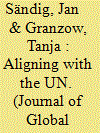

|
|
|
|
|
| Summary/Abstract |
Self-determination campaigns in the Global South have often been pursued through warfare. Since the 1990s, however, an increasing number of such movements have endorsed legalistic mechanisms of international law and the UN's core principle of nonviolence. We introduce the concept of UN-aligned self-determination movements for them. As a starting point to explain their occurrence, we examine two major cases: The Peaceful Southern Movement (Hirak) in Yemen and the Movement for the Actualization of the Sovereign State of Biafra (MASSOB) in contemporary Nigeria. Our analysis combines theories on political opportunities, diffusion, and framing from social movement, civil resistance, and armed rebellion research. We observe that since the end of the Cold War the rule of law, role of the UN, and norms of nonviolent conflict resolution have been strengthened in the international system. We argue that this has given self-determination movements in the Global South new opportunities for claims-making: Facing repressive governments, the leaders of Hirak and MASSOB have successfully aligned their movements with the UN by diffusing its core principles to the local struggle through resonant collective action frames. Thereby, our study contributes to understanding the diffusion of nonviolence in the international system, in particular in self-determination campaigns, and directs attention to the rise of UN-aligned self-determination movements.
|
|
|
|
|
|
|
|
|
|
|
|
|
|
|
|
| 2 |
ID:
113882
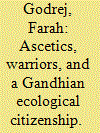

|
|
|
|
|
| Publication |
2012.
|
| Summary/Abstract |
I argue here that a clearer conception of Gandhi's nonviolence is required in order to understand his resonance for contemporary environmentalism. Gandhi's nonviolence incorporates elements of both the brahmin or ascetic, as well as the ksatriya or warrior. Contemporary environmental movements by and large over-emphasize the self-abnegating, self-denying and self-scrutinizing ascetic components of Gandhi's thought, to the neglect of the confrontational and warrior-like ones. In so doing, they often also over-emphasize the ethical dimension of Gandhi's thought, missing the discursive political dimension with which this Gandhian ethics is interwoven. I will argue here that the warrior-like and confrontational political aspect of Gandhi's nonviolence must be brought to the fore in discussions of environmentalism. In so doing, Gandhi can be read as an advocate of a certain form of "ecological" citizenship, requiring both the scrutiny of one's bodily consumptive behaviours, as well as the placement of one's body on the frontlines of aggressive political contestation.
|
|
|
|
|
|
|
|
|
|
|
|
|
|
|
|
| 3 |
ID:
148936
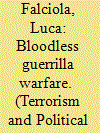

|
|
|
|
|
| Summary/Abstract |
Between 1968 and the late 1970s, a significant number of U.S. white leftist groups escalated their protest to armed struggle. After experimenting briefly with violence, they opted for low-intensity armed propaganda that targeted property and avoided hurting people. By contrast, European leftist groups and anti-colonial organizations in the U.S. made extensive use of antipersonnel violence. Why did U.S. leftists eschew attacks against civilians? Scholarship does not explain this case, as it focuses either on the internal dynamics of a single group or on structural variables. Conversely, this article addresses this question through a historical reconstruction and a multilevel analysis. The research identifies the critique and ensuing de-solidarization by the radical milieu as the main factor accounting for the restraint of violence. This article demonstrates that the radical milieu censored and isolated armed groups as soon as they escalated and began to endanger human lives. Therefore, in order to safeguard the solidarity pact with their constituencies, violent fringes moderated their repertoires of action. This article employs primary sources and original interviews with militants to support this claim and to assess the relevance of three concurrent factors: the trauma generated by the “townhouse incident,” the deterrence by law enforcement, and the militants’ socio-economic background.
|
|
|
|
|
|
|
|
|
|
|
|
|
|
|
|
| 4 |
ID:
190024
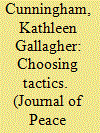

|
|
|
|
|
| Summary/Abstract |
Disputes over self-determination (SD) have led to many civil wars, and a primary alternative, nonviolent campaign, is rarely successful in this context. Yet, while secession is rare, these movements often achieve more limited successes in the form of concessions from the state. This article provides a new assessment of the efficacy of different tactics – violent, nonviolent and conventional political action. It advances an argument that nonviolent tactics can help SD movements to generate indirect pressure on states that contributes to movement success, including greater autonomy. Nonviolence is used to garner attention from international actors using a human rights frame for their cause. International actors that are receptive to these human rights narratives then incentivize concessions for the SD movements and dis-incentivize repression. This happens through a variety of means, such as public shaming of the host state and withholding inter-governmental organization membership. Statistical analysis of violent and nonviolent tactics in SD movements shows that nonviolence can be effective in successfully obtaining concessions. Movements that use nonviolence are twice as likely to see concessions in any given year compared to those that just make demands but do not use nonviolence or violence. The effect of nonviolence is slightly larger than that of violence, which is also associated an increased chance of concession.
|
|
|
|
|
|
|
|
|
|
|
|
|
|
|
|
| 5 |
ID:
142038


|
|
|
|
|
| Summary/Abstract |
Violent domestic conflicts spread between countries via spillover effects and the desire to emulate events abroad. Herein, we extend this emulation logic to the potential for the contagion of nonviolent conflicts. The spread of predominantly nonviolent pro-democracy mobilizations across the globe in the mid-to-late 1980s, the wave of protests in former Soviet states during the Color revolutions in the 2000s, and the eruption of nonviolent movements across the Middle East and North Africa during the Arab Spring in the early 2010s each suggest that the observation of collective action abroad encourages a desire to emulate among potential challengers to domestic autocrats. However, the need to emulate varies. Potential challengers with a recent history of protest at home are less dependent (than are those without similar experience) upon foreign exemplars to mobilize the participants and generate the resources required to make emulation practicable. By contrast, where the domestic experience of protest is absent, opposition movements are more reliant upon emulation of foreign exemplars. We test the implications of this logic using a series of multivariate logistic regression analyses. Our tests employ data on nonviolent civil resistance mobilizations that occurred across the global population of autocratic states between 1946 and 2006. These tests, along with post-estimation analysis, provide evidence consistent with our conditional logic of emulation.
|
|
|
|
|
|
|
|
|
|
|
|
|
|
|
|
| 6 |
ID:
167288
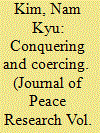

|
|
|
|
|
| Summary/Abstract |
Recent research finds an association between nonviolent protests and democratic transitions. However, existing scholarship either does not specify the pathways through which nonviolent protests bring about democratization or conduct systematic empirical analyses demonstrating that the specified pathways are operative. This article proposes four pathways through which nonviolent anti-regime protests encourage democratic transitions, emphasizing their ability to directly conquer or indirectly coerce such transitions. Most simply, they can conquer democratic reforms by directly overthrowing authoritarian regimes and installing democracies. They can also coerce democratic reforms through three additional pathways. Nonviolent anti-regime protests can coerce incumbent elites into democratic reforms by threatening the survival of authoritarian regimes. They also increase the likelihood of elite splits, which promote negotiated democratic reforms. Finally, they encourage leadership change within the existing authoritarian regime. Following leadership change, nonviolent movements remain mobilized and are able to coerce democratic concessions from the regime’s new leaders. Our within-regime analyses provide robust empirical support for each pathway. We show that nonviolent anti-regime protests conquer democratic reforms by ousting autocratic regimes and replacing them with democracies. Nonviolent anti-regime protests also coerce elites into democratic reforms by threatening regime and leader survival. These findings highlight the importance of protest goals and tactics and also that nonviolent anti-regime protests have both direct and indirect effects on democratization.
|
|
|
|
|
|
|
|
|
|
|
|
|
|
|
|
| 7 |
ID:
037785
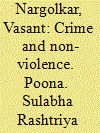

|
|
|
|
|
| Publication |
Poona, Sulabha Rashtriya Granthamala Trust, 1974.
|
| Description |
xi, 287p.
|
|
|
|
|
|
|
|
|
|
|
|
Copies: C:1/I:0,R:0,Q:0
Circulation
| Accession# | Call# | Current Location | Status | Policy | Location |
| 014915 | 364.1066/NAR 014915 | Main | On Shelf | General | |
|
|
|
|
| 8 |
ID:
172103
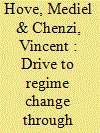

|
|
|
|
|
| Summary/Abstract |
This article examines efforts made by the Movement for Democratic Change Alliance to bring about regime change through nonviolent economic warfare including its subsequent failure. The 30 July 2018 harmonised elections in Zimbabwe led to a victory by Emmerson Mnangagwa but it was disputed by Nelson Chamisa. Since August 2018, the political opposition led by Chamisa sought to make the country ungovernable by waging a nonviolent economic war nicknamed Kuzvidira jecha (pouring sand) against the Mnangagwa administration. This was punctuated by price hikes, fluctuation of the local currency, artificial food stuff price hikes and fuel shortages which caused serious challenges for most Zimbabweans. This was primarily intended to bring about regime change via public unrest against the Mnangagwa regime. On the contrary, the anticipated public uproar failed to foster regime change in Zimbabwe despite widespread adverse socio-economic effects. This led to the nonviolent participants resorting to violent tactics instead of adhering to nonviolence. Consequently, it was the failure to adhere to nonviolent principles by opposition advocates which forced the Mnangagwa regime to deploy its own instruments of violence in an effort to protect lives and property.
|
|
|
|
|
|
|
|
|
|
|
|
|
|
|
|
| 9 |
ID:
160474
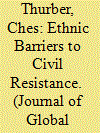

|
|
|
|
|
| Summary/Abstract |
While ethnic cleavages have featured prominently in our understanding of civil wars, attention to ethnic and social structures has been surprisingly absent from the recent wave of research on civil resistance. Yet these structures likely have an important impact on when and where we see nonviolent campaigns occur. This article argues that the strategic logic of civil resistance presents high barriers to entry for politically excluded ethnic minorities. Constraints on these groups’ ability to activate mechanisms central to an exclusively nonviolent strategy either prevent them from getting a civil resistance campaign off the ground or deter them from ever attempting to do so. Using original data on the ethnic composition of nonviolent and violent campaigns, I show that nonviolent campaigns are less likely than violent ones to include participants from politically disadvantaged ethnic groups and also less likely to feature ethnic political claims. Furthermore, I find that political exclusion and small group size reduce the likelihood that members of an ethnic group will initiate a campaign of civil resistance.
|
|
|
|
|
|
|
|
|
|
|
|
|
|
|
|
| 10 |
ID:
141617
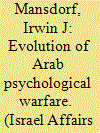

|
|
|
|
|
| Summary/Abstract |
Psychological warfare is a ‘soft power’ technique used to attain strategic objectives. In the Israeli–Palestinian dynamic, psychological warfare has evolved to where it now shares goals with ‘public diplomacy’ as a means of influencing policy and politics. Arab strategy has moved from ineffective attempts to influence the Israeli public to credible and cynical strategies that often involve a disregard for and exploitation of civilian casualties and the appearance of embracing ideology associated with revolutionary figures and human rights. ‘Non-violent resistance’ invoking Gandhi, Mandela and King as models for Palestinian Arab strategy is now common and serves to attract sympathy. Despite claiming a philosophy of nonviolence, the goal of many anti-Israel groups remains the dissolution of Israel as the state of the Jewish people.
|
|
|
|
|
|
|
|
|
|
|
|
|
|
|
|
| 11 |
ID:
160473
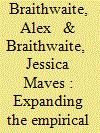

|
|
|
|
|
| Summary/Abstract |
This article introduces a special issue of Journal of Global Security Studies on advances in the disaggregated study of actors and tactics in nonviolent civil resistance campaigns. We initially discuss the recent rise of empirical, primarily quantitative research on nonviolence and civil resistance. We then note that the latest innovations in this literature are providing a disaggregated perspective on the actors engaging in nonviolence, as well as the tactics that they employ in doing so. In many respects, this direction parallels that taken in the study of civil wars over the past two decades. At the heart of this evolution in the research agenda on nonviolence is the availability of new, more nuanced data. The five articles in this issue very neatly demonstrate best practices in asking compelling research questions, deriving nontrivial hypotheses, and providing new data on the disaggregated nature of campaigns of nonviolent resistance.
|
|
|
|
|
|
|
|
|
|
|
|
|
|
|
|
| 12 |
ID:
134150
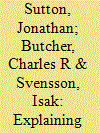

|
|
|
|
|
| Publication |
2014.
|
| Summary/Abstract |
The use of violent coercion to repress unarmed protests, such as that seen during the Arab Spring, sometimes backfires on the government - an outcome called 'political jiu-jitsu'. Examining unique global data covering extreme violence used by governments against unarmed protests from 1989 to 2011 (drawn from UCDP) and the Nonviolent and Violent Campaigns and Outcomes (NAVCO) data, this study aims to explain the conditions under which this outcome occurs. This study contributes to both the nonviolent action and one-sided violence literatures by further disaggregating this effect into both domestic and international outcomes, a distinction that has not previously been made in empirical studies. We find evidence that a pre-existing campaign infrastructure increases the likelihood of increased domestic mobilization and security defections after violent repression, but is unrelated to international backlash. Within ongoing NAVCO campaigns we find that parallel media institutions increase the likelihood of increased domestic mobilization and international repercussions after repression, and that this effect holds true for both traditional media and 'new' (i.e. internet-based) media. One of the novel contributions of this study is that we identify an important selection effect in the NAVCO data and the critical role of organizational infrastructure, especially communications infrastructure, in generating preference changes that create the conditions where killing unarmed civilians becomes costly for repressive governments. We conclude with a discussion of the potential implications of this study and avenues for future research.
|
|
|
|
|
|
|
|
|
|
|
|
|
|
|
|
| 13 |
ID:
121598


|
|
|
|
|
| Publication |
2013.
|
| Summary/Abstract |
Although pacifism and nonviolence bear a close relationship to one another historically, pacifism is the ideological assertion that war and violence should be rejected in political and personal life, whereas nonviolence refers to a distinct set of political practices. Unlike other modern ideologies such as liberalism and socialism, pacifism has never gained widespread acceptance among a significant portion of humanity and seems to remain a minority position among most of the peoples of the world. Even among those who use nonviolent techniques, the conventional wisdom that physical violence is necessary under certain circumstances often prevails. However, a growing body of empirical evidence shows that the methods of nonviolence are more likely to succeed than methods of violence across a wide variety of circumstances and that more people are using nonviolence around the world. At the same time, both the effectiveness of military and material superiority in achieving political ends and the incidence of warfare and violence appear to be waning. In a remarkable example of convergence between empirical social science and political theory, explanations for the effectiveness of nonviolence relative to violence point to a people-centered understanding of power. This research can provide a basis for a reinvigorated and pragmatic brand of pacifism that refocuses the attention of political scientists on the organization, actions, and loyalties of people as opposed to technologies of domination and destruction.
|
|
|
|
|
|
|
|
|
|
|
|
|
|
|
|
| 14 |
ID:
047229
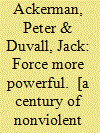

|
|
|
|
|
| Publication |
New York, Palgrave, 2000.
|
| Description |
xiii, 544p.
|
| Standard Number |
0312228643
|
|
|
|
|
|
|
|
|
|
|
|
Copies: C:1/I:0,R:0,Q:0
Circulation
| Accession# | Call# | Current Location | Status | Policy | Location |
| 044192 | 303.61/ACK 044192 | Main | On Shelf | General | |
|
|
|
|
| 15 |
ID:
120773


|
|
|
|
|
| Publication |
2013.
|
| Summary/Abstract |
Whereas optimists see the so-called Arab Spring as similar to the revolutions of 1989, and likely to bring about democratic rule, skeptics fear that protest bringing down dictators may simply give way to new dictatorships, as in the Iranian revolution. Existing research on transitions has largely neglected the role of protest and direct action in destabilizing autocracies and promoting democracy. We argue that protest and direct action can promote transitions in autocracies, and that the mode of direct action, that is, whether violent or nonviolent, has a major impact on the prospects for autocratic survival and democracy. We present empirical results supporting our claim that nonviolent protests substantially increase the likelihood of transitions to democracy, especially under favorable international environments, while violent direct action is less effective in undermining autocracies overall, and makes transitions to new autocracies relatively more likely.
|
|
|
|
|
|
|
|
|
|
|
|
|
|
|
|
| 16 |
ID:
106364
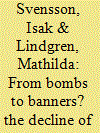

|
|
|
|
|
| Publication |
2011.
|
| Summary/Abstract |
One of the most important debates in the field of peace and conflict research concerns whether wars and armed conflicts are declining over time. The region where this plays out most markedly is East Asia: having suffered some of the world's most brutal wars in the period prior to 1979, the region has since witnessed an era of relative peacefulness. This article asks whether the decline in the level of war in the region reflects a change in the means used to pursue conflicts: are conflicts that previously were fought with arms increasingly manifested through unarmed uprisings based on strategic nonviolent actions? Examining the empirical patterns of armed conflicts and unarmed uprisings in the region, the article shows that there has been a substantial increase in the number of unarmed uprisings in East Asia that runs parallel with a decrease in the intensity and frequency of warfare. Yet, the article also shows that these nonviolent uprisings do not follow on from previous armed campaigns, and that armed and unarmed campaigns differ in terms of aims, nature and outcome. Thus, the article concludes that there is little support for the hypothesis that those who formerly used violence have shifted to new nonviolent, unarmed tactics, and that we are rather witnessing two parallel, unrelated processes. These insights call for an enlargement of the research agenda of the 'East Asian peace'.
|
|
|
|
|
|
|
|
|
|
|
|
|
|
|
|
| 17 |
ID:
152612
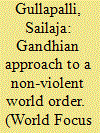

|
|
|
|
|
| Summary/Abstract |
The world has always been afflicted with conflicts of all sorts. The last two centuries have been extremely conflict-prone with persistent problems, two major world wars and many proxy wars. While wielding of power remains the prime motive of these conflicts, many of them are acts of retaliation too. Partly, it can be attributed to deficiency in the spiritual and ethical values that are much affecting the contemporary international relations. Wars are being waged for establishing the so-called democracies, overthrowing dictatorships, wars on terror, and wars to liberate people from state oppressions.
|
|
|
|
|
|
|
|
|
|
|
|
|
|
|
|
| 18 |
ID:
128748
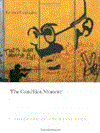

|
|
|
|
|
| Publication |
Cambridge, Harvard University Press, 2013.
|
| Description |
xii, 196p.Hbk
|
| Standard Number |
9780674065956
|
|
|
|
|
|
|
|
|
|
|
|
Copies: C:1/I:0,R:0,Q:0
Circulation
| Accession# | Call# | Current Location | Status | Policy | Location |
| 057652 | 954.035092/JAH 057652 | Main | On Shelf | General | |
|
|
|
|
| 19 |
ID:
154067
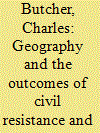

|
|
|
|
|
| Summary/Abstract |
This paper reports the results of the first cross-national examination of the impact of the geography of nonviolent contention on regime transitions. Nonviolent tactics ‘work’ in part by signalling the preferences of non-participants through the symbolism of participants, unlike violent tactics. This opens the way for nonviolent campaigns to exploit variations in social-spatial meaning to enhance the informativeness of dissent. Capital cities are one such symbolic place and the main prediction of this study is a positive relationship between large protests and regime transitions in the capital, but not elsewhere. I also predict a strong direct relationship between the proximity to the capital of fighting in civil wars, and regime transitions; no relationship to the proximity of nonviolent contention; and that the intensity of violent conflict impacts regime transitions in a way that is largely independent of location. Results from an analysis of episodes of violent and nonviolent conflict from 1990 to 2014 generally support these contentions.
|
|
|
|
|
|
|
|
|
|
|
|
|
|
|
|
| 20 |
ID:
192870


|
|
|
|
|
| Summary/Abstract |
We examine how popular dissent affects the likelihood that political leaders lose power, distinguishing between types of dissent in terms of nonviolent/violent primary tactics as well as the level of individual participation. We posit that protests threaten leaders both directly through the governance costs of citizen non-compliance, and indirectly through the increased risk of elite defections in the ruling coalition. In a series of propositions we detail how the type of dissent and the magnitude of participation influence the odds of leaders surviving in office. We argue that mass nonviolent challenges tend to be more threatening to a leader’s rule than violent dissent, given the characteristics of movements likely to choose nonviolent tactics. Moreover, the effectiveness of the challenge increases in the scale and size of the dissident campaign, and movements that can mobilize larger numbers have a comparative advantage in nonviolent tactics. Employing data on political leaders’ tenure and dissident campaign characteristics, we provide evidence consistent with our expectations.
|
|
|
|
|
|
|
|
|
|
|
|
|
|
|
|
|
|
|
|
|